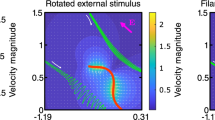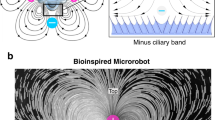Abstract
Directional near-wall flow induced by the vibration of slender micro-pillars attached to a surface similar to ciliary structures or grafted filaments is studied experimentally. The micro-pillar arrays are arranged in the form of a “V” approximating an asymmetric fore-aft bundle shape often found in nature, too. A base-layer actuation is used to excite the micro-pillars to oscillate in a vibratory pattern with maximum amplitude at the tips. Due to the specific shape of the bundle structure and asymmetric boundary conditions of the oscillatory motion, the pillars perform a tilted beating motion—similar to cilia—with a forward power stroke and a backward oriented recovery stroke or vice versa, depending on the boundary conditions of the actuation. As a consequence of the cooperative beating motion and the fore-aft asymmetry of the shape of the bundle, a directional streaming motion is induced by the pillars which increase with increasing streaming Reynolds number Re S . In addition to the net streaming effect, the flow in the space between the pillar bases exhibit a micro-scale swirling motion around each of the structures with an efficient mixing behavior. Applied to micro-channels or wall-bounded flows, such structures may act as locally distributed passive or active flow manipulation devices. The use of such cilia bundles in large numbers on surfaces as passive structures for near-wall control in of boundary layer flows is feasible, too.










Similar content being viewed by others
References
Berman NS (1978) Drag reduction by polymers. Ann Rev Fluid Mech 10:47–64
Brennen Ch, Winet H (1977) Fluid mechanics of propulsion by cilia and flagella. Ann Rev Fluid Mech 9:339–398
Brücker Ch (2008) Signature of varicose wave packets in the viscous sublayer. Phys Fluids 20:061701. doi:10.1063/1.2945292
Brücker Ch, Spatz J, Schröder W (2005) Feasibility study of wall shear stress imaging using microstructured surfaces with flexible micropillars. Exp Fluids 39(2):464–474
Brücker Ch, Bauer D, Chaves H (2007) Dynamic response of micro-pillar sensors measuring fluctuating wall-shear stress. Exp Fluids 42(5):737–749
Groisman A, Quake SR (2004) A microfluidic rectifier: anisotropic flow resistance at low reynolds numbers. Phys Rev Lett 92:094501
Karavitaki KD, Mountain DC (2003) Biophysics of the cochlea: from molecules to models. In: Gummer AW (ed) Is the cochlea amplifier a fluid pump? World Scientific, Singapore, pp 310–311
Kim MJ, Breuer KS (2007) Use of bacterial carpets to enhance mixing in micro systems. J Fluids Eng 129:319–324
Kim MJ, Breuer KS (2008) Self-organizing bacteria-powered microfluidic pump. Small 4(1):111–118
Kim YW, Netz RR (2006) Pumping fluids with periodically beating grafted elastic filaments. Phys Rev Lett 96(11):158101
Landahl MT (1977) Dynamics of boundary layer turbulence and the mechanism of drag reduction. Phys Fluids 20(10):55–63
Meinhart CD, Werely ST, Santiago JG (2000) A PIV algorithm for estimating time-averaged velocity fields. J Fluids Eng 122:285–289
Nowotny M, Gummer AW (2006) Nanomechanics of the subtectorial space caused by electromechanics of the outer hair cells. Proc Natl Acad Sci USA 103:2120–2125
Nyborg WL (1965) Acoustic streaming. In: Mason W (ed) Physical acoustics IIB. Academic Press, New York, pp 265–331
Pau HW, Pau H (2006) Does the geometrical arrangement of the outer hair cell stereocilia perform a fluid-mechanical function? Acta Oto-Laryn 126:570–576
Ptasinski PK, Boersma BJ, Nieuwstadt FTM et al (2003) Turbulent channel flow near maximum drag reduction: simulations, experiments and mechanisms. J Fluid Mech 490:251–291
Riley N (2001) Steady streaming. Ann Rev Fluid Mech 33:43–65
Sagong W, Kim C, Choi S, Jeaon W, Choi H (2008) Does the sailfish skin reduce the skin friction like the shark skin? Phys Fluids 20:101510
Schmitz GJ, Brücker Ch, Jacobs P (2005) Manufacture of high-aspect-ratio micro-hair sensor arrays. J Micromech Microeng 15:1904–1910
Sirovich L, Karlsson S (1997) Turbulent drag reduction by passive mechanism. Nature 388:753–755
Toonder J, Bos F, Broer D et al (2008) Artificial cilia for active micro-fluidic mixing. Lab Chip 8(4):533–541 Epub 2008
Vogel S (1994) Life in moving fluids. Princeton University Press, Princeton
Wei T, Willmarth WW (1992) Modifying turbulent structure with drag-reducing polymer additives in turbulent channel flows. J Fluid Mech 245:619–641
Zhou J, Adrian RJ, Balachandar S, Kendall TM (1999) Mechanisms for generating coherent packets of hairpin vortices in near-wall turbulence. J Fluid Mech 387:353–396
Acknowledgments
The authors acknowledge the funding of this study by the German Research Foundation DFG in the focus research program SPP 1164 “Nano- and microfluidics” under the contract # BR 1494/15-3.
Author information
Authors and Affiliations
Corresponding author
Rights and permissions
About this article
Cite this article
Brücker, C., Keissner, A. Streaming and mixing induced by a bundle of ciliary vibrating micro-pillars. Exp Fluids 49, 57–65 (2010). https://doi.org/10.1007/s00348-009-0774-7
Received:
Revised:
Accepted:
Published:
Issue Date:
DOI: https://doi.org/10.1007/s00348-009-0774-7




